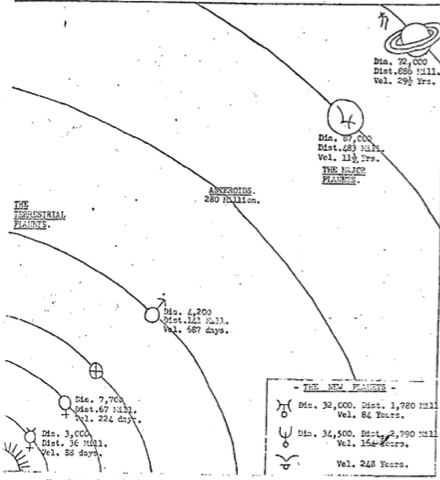–THE TRADITIONAL PLANETS OF ANTIQUITY–

Lectures
Perth, Western Australia, 1951 - 1952
SERGE RAYNAUD de la FERRIÈRE
THE UNIVERSAL GREAT BROTHERHOOD. AQUARIAN MISSION PERTH CENTER. |
CREMORNE HALL. Friday, 8th , June, 1951. LESSON:- MISS NAGEL |
–THE TRADITIONAL PLANETS OF ANTIQUITY–

The above chart depicts the Traditional Planets of Antiquity which appear in our Solar System. Dealing with them in their order of proximity to the Sun, they appear as follows:-
THE TERRESTRIAL PLANETS.
1. Mercury, Diameter, 3,000 miles, Distance from the Sun: 36, 000,000 miles. Time taken to make a complete revolution of the Sun, 88 days.
Mercury is named thus because of its attachment to the Sun, and because it is clouded by the brilliance of the Sun, it is rarely seen, except under exceptional circumstances.
2. Venus: Diameter, 7,700 miles. Distance from the Sun, 67,000,000 miles. Time taken to make a complete revolution of the Sun, 224 days. Venus, known for her silvery splendour is about the same size as our Earth, and is often seen in conjunction with the Sun because it is near enough to be in conjunction, and yet far enough away not to be clouded out and therefore can be seen. Mercury and Venus are always near to the Sun and never leave it.
3. Earth: This being the Planet on which we reside, we are not dealing extensively with it, because for the purposes of Astrology we are interested in the construction and particularly the effects of the other Planets of the Solar System in relation to the Earth.
4. Mars: Diameter, 4,200 miles. Distance from the Sun, 141,000,000 miles. Time taken to make a complete revolution of the Sun, 687 days. It is recorded that this Planet is much smaller than our Earth.
THESE FOUR PLANETS ARE KNOWN AS THE TERRESTRIAL PLANETS.
After these come the Asteroids at a distance of 280,000,000 miles. Little is known about them, though it is generally believed that they belong to each other and also to the Sun. It can be seen that they are at a much further distance from the Sun than the Terrestrial Group.
5. Jupiter: Diameter, 87.000 miles. Distance from the Sun, 483.000.000 miles. Time taken to make a complete revolution of the Sun, 11 ½ years. This is an enormous Planet, and is referred to as the Giant Planet of our Solar System. It is attended by a number of Moons said to be as large as Mercury.
6. Saturn: Diameter, 72.000 miles. Distance from the Sun, 886,000,000 miles. Time taken to make a complete revolution of the Sun, 29 ½ years. As can be seen this Planet is a much further distance out even than Jupiter. It is a fascinating subject to Astronomers and Astrologers because of the rings that surround it, and is a most glorious Planet to be seen in our Heavens.
All the above Planets can be seen with the naked eye (under favourable conditions), the four Terrestrial Planets because of their proximity, and Jupiter and Saturn because of their size.
THE NEW PLANETS:
Uranus: Diameter, 32,000 miles. Distance from the Sun, 1,780,000,000 miles. Time taken to make a complete revolution of the Sun, 84 years.
Neptune: Diameter, 34,500 miles. Distance from the Sun, 2,790,000,000 miles. Time taken to make a complete revolution of the Sun, 164 years.
These two Planets are estimated to be about 4 times the size of our Earth.
Pluto: Due to the very recent discovery of this Planet (1930) very little is known about it. It is estimated that it takes 248 years to make one revolution round the Sun.
CHART SHOWING POSITION OF PLANETS
At 12 Moon G.M.T.
Friday, 8th, June, 1951.
|
|
|
The above indicates the positions of the Planets in the respective Constellations in degrees, minutes and seconds, or in degrees and minutes only, whichever the case may be. From this the student is requested to do the following:-
|
-----o0o-----